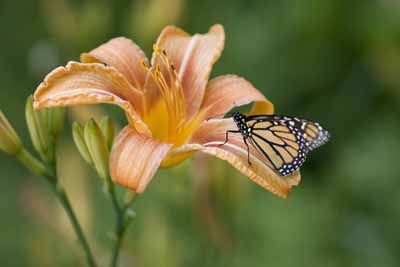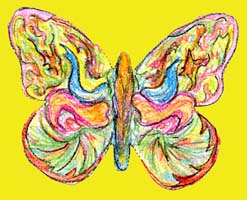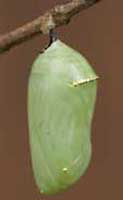Monarch Butterfly
Arts, Music and Environmental Workshop:

A symbolic migration linking
art, environment, and communities.
Monarch Butterfly Arts, Music and Environmental Workshop brings together children of
the United States and Mexico. Every year, children
in North America create paper butterflies and send
them to the children who live beside the monarch sanctuaries in the
Oyamel. The children of the Oyamel region take care of the
butterflies all winter, and in the spring send them back, completing
the “migration” of the paper butterflies.
The program
teaches about the conservation of the forests and the monarchs, raising
environmental awareness, as well as creating a bond between children of
two different parts of the world.

The butterflies’ fall flight is timed to
correspond with the real
monarchs’ journey south. The paper butterflies arrive in
Mexico
around the time of the Dia de los Muertos (November 2), just as the
real monarchs do. According to Mexican legend, these returning
butterflies are thought to carry the ancestors’ souls and
play a role in the Dia de los Muertos celebrations.
Mexican students from the sanctuary region greet the
butterflies and
watch over them during the winter months. At the same time in the
mountains nearby, the entire eastern population of North American
monarch butterflies is resting in Mexico for the winter. Sometime next
March, when the real monarchs’ departure from Mexico is
announced, the paper butterflies will return. The butterflies will
carry a special message from the Mexican students to the students in
Canada and U. S. who made them.
  
Children from the Jamaica Plain KidsArts! summer camp
were able to hold live Monarch Butterflies!!!
During the day long park stewardship workshop
Any donations made through the Monarch Butterfly Arts, Music and Environmental Workshop program go to
fund the efforts of the Monarch
Butterfly Sanctuary Foundation, which
works to protect both the Oyamel forests and support the people who
live around them. Monarch Butterfly Arts, Music and Environmental Workshop is modeled after and
supports the Journey North's Symbolic Migration http://www.learner.org/jnorth/monarch/
Every year, millions of monarch butterflies migrate
from eastern North
America to the Oyamel fir forests of Mexico. The Oyamel
forests are located in the mountains of central Mexico, and their
unique ecosystem is essential to the survival of the monarch.
The
monarchs spend the winter there, then migrate back north in the spring
to lay their eggs on the milkweed plants of North America.

|
How to Participate in the Monarch Butterfly Arts, Music and Environmental Workshop
Workshops and performances include:
- Environmental songs, music, puppets and costume performance by Stephen Baird
- Live Monarch Butterfly, Caterpillar, and Chrysalis (May-August)
- Monarch Butterfly Life Cycle Exhibit and Display
- Paper Butterflies for Participants.
- Internet Educational Materials and Resources (See below)
- Paper Butterfly Exhibit and Optional Paper Butterfly Internet Exhibit of Participants' Paper Butterflies
Workshops and performances fees:
- One hour performance and workshop. Participants keep paper butterflies to create art work and send in later. Fee: $400
- One
hour performance and workshop. Live Monarch Butterfly,
Caterpillar, and Chrysalis (May-August).Participants keep paper
butterflies to create art work and send in later. Fee: $500
- Two hour performance and workshop. Participants create peper butterflies after workshop. Fee: $600
- Two performances and workshops. Includes Paper Butterfly Exhibit when they return from Mexico. Fee: $800
- Optional Latin-American and Mexican-American music and dance performances for final exhibit celebration. Fee: Call
- Twenty
percent of fees is donated to Monarch Butterfly habitat conservation in
United States and Mexico. Additional donations welcomed!
Butterfly Making Instructions:
-
Butterflies should be smaller than 1/2 piece of paper (5
1/2"
x 8”). A template is included if you wish to use
it.
Click HERE
-
Should be made entirely from paper. (Please use recycled
paper!)
-
Should be flat and have no 3D decorations or glitter.
-
Include student's first name clearly written on each
butterfly.
-
Butterflies are ambassadors, and carry messages of support
and gratitude to Mexican students, clearly typed.
- Mail your butterflies and donations to: Community Arts Advocates, Inc., PO Box 300112, Jamaica Plain, MA 02130
English/Spanish Phrases to Use on Butterflies
My name is ________
Mi nombre es ________
I am ______ years old.
Tengo _____.
I live in the state of ____________
Vivo en el estado de____________
The name of my
school is ________
El nombre de mi escuela es________
I am in ______ grade.
Estoy en______grado.
Thank you for taking care of the monarchs this winter, from your
northern neighbors.
Gracias por cuidar a las mariposas monarcas este invierno, de parte de
sus vecinos del norte.
Please take care of this butterfly during the long, cold northern
winter.
Por favor cuiden a esta mariposa durante el frío y largo invierno del
norte.
To help monarch habitat in the north, I planted a butterfly garden.
Para ayudar a mejorar el hábitat de las mariposas monarcas en el norte,
planté un jardín de flores.
To help monarchs I raised a real monarch and let it go.
Para ayudar a las mariposas monarca, crié una mariposa de verdad y la
dejé en libertad.
Monarch butterflies are shared by the people of Canada, and the United
States and Mexico.
Las mariposas monarcas son un recurso natural compartidas por los
países de Canada, Estados Unidos y Mexico.
Of all the countries on Earth, Mexico is the 4th richest in
biodiversity.
De todos los paises del mundo, México es el cuarto país más rico en
biodiversidad.
Copy of
Instructions Click HERE
|
Workshop
Event Dates
Butterflies
Over
Boston,
12th Annual
Monarch
Butterfly Migration and Summer Solstice Celebration, Sunday, June 17th, 2012. 1-3 PM;
Jamaica Pond Gazebo, Pond Street and the Jamaicaway, Jamaica Plain, MA 02130; Featuring: Live
Monarch chrysalis and caterpillars 1-3 PM; LaPinata - Latin American and Mexican Dance and Music http://lapinata.org at 2 PM.
Info: 617-522-3407 Past events and history of the celebration created
by Marianne Donnelly HERE
  
La Pinata - Latin American Dance and Music - Rosalba Solis, Director
July 4, 2010 -- Butterflies and Barbecue, Fenway Victory Gardens, 2-6 PM, Free

Photo: Stephen Baird
Fenway
Garden Society will host a free public event on the Fourth of July.
Featuring barbecue lunch, fun contests, musical entertainment by
saxophonist Kenji Kikuchi, and a special Monarch butterfly art and
conservation workshop, the festival runs from 2-6 pm, rain or shine,
and is free and open to the public.
The Monarch Butterfly Art and Conservation Workshop by
Emerald Necklace naturalist Stephen Baird will include a paper
butterfly contest— both children and adults are welcome to participate! Learn about the
Monarch butterfly, see the live butterfly displays, create your own
butterfly and discover ways to enhance conservation for this important
and beneficial insect.
Fenway Garden Society, P.O. Box 230038, Boston, MA 02123 http://fenwayvictorygardens.com
Monarch
Butterflies:

Life
Cycle
The monarch butterfly goes through
four different
stages
during its life: egg, caterpillar, chrysalis, and butterfly.
The
whole process of going from an egg to a butterfly is called
metamorphosis.
The butterfly
begins as an egg, which its mother lays underneath the
leaves of the milkweed plant. The egg takes two weeks to
develop,
and its color changes from yellow to light gray.
At the end of the
two weeks, the egg opens and out comes a tiny
caterpillar. The caterpillar does nothing but eat the leaves
of
the milkweed plant and grow. The caterpillar grows to be up
to
two inches long, which it does by shedding its skin several
times. When it is ready, the caterpillar then finds a safe
place
to undergo the process of becoming a butterfly. Using a
special
gland in its mouth, the caterpillar weaves a small silk button
underneath a twig or leaf, and then attaches its tail end to the button.
The caterpillar
hangs upside down from the button in a J
shape.
For up to five hours, it sheds its skin until it looks like a giant
green water droplet. This green outer layer hardens, and the
caterpillar is now in the chrysalis stage. For two weeks the
caterpillar is busy transforming inside the chrysalis.
At the end of the
two weeks, the butterfly has completed its
transformation, and the new butterfly emerges from its
chrysalis.
It first sits and waits for its wings to dry, then when it is ready, it
flies away.
  
Photographs by Stephen Baird
Migration
The monarch butterfly must travel a very long
way to make
it to Massachusetts and New England. Every year, tens of
millions of monarchs complete
the journey from the Oyamel fir forests of Mexico to eastern North
America and back, a cycle that takes four generations of monarchs to
complete. The monarchs migrate to Mexico in order to avoid
the
cold temperatures of the northern winter, but they must fly back every
spring because milkweed plants, which are the only food source for the
caterpillar, do not grow in the Oyamel forests. Although the
butterflies who reach Mexico each year are four generations removed
from the butterflies who arrived the previous year, the monarchs always
know the way and even stay in the same trees year after year.
A
single Oyamel fir tree can be filled with as many as 50,000 butterflies
at
one time.
The
Oyamel fir forests are
located in the mountains of central Mexico, covering an area of about
60 square miles. The unique ecosystem of the Oyamel is key to the
monarch’s winter survival. The cool weather enables the
butterflies to conserve their energy reserves for the return journey
north. The trees create a buffer to harsh weather such as
wind,
cold, snow, and rain. The nearby streams provide a source of
water for the monarchs. The frequent fog and clouds provide
moisture to prevent hot temperatures from drying out the
monarchs’ bodies.
- The Threat to the Forests
Unfortunately,
the
forests, which are essential to the continued survival of the monarch
butterfly, are being threatened. Logging occurs in the area,
as
local residents of the region cut down the trees of the Oyamel forests
for personal and commercial reasons. In 1986 a presidential
decree was passed by the Mexican government that created the
“Reserva de la Biosfera Mariposa Monarca,” or the Monarch
Butterfly Special Biosphere Reserve. This decree created
zones of
protection in five of the 13 known monarch overwintering sites.
However, both illegal and legal cutting still continue, posing a threat
to the monarch’s habitat.
A
solution must be found
that addresses both the long-term conservation of the dwindling Oyamel
forest and the needs of the people who depend on the forest for
survival, allowing both interests to live together in a sustainable
manner. The Monarch Butterfly Sanctuary Foundation is one
group
who addresses this problem by focusing on environmental education,
economic development, and research. The project connects the
monarchs, those who care about them, and the people of the Oyamel,
working towards a solution that addresses the needs of each party.
Fun Facts:
Migration Discover Tales -- Dr. Fred Urquhart from
Toronto, Canada, spent 40 years looking for the wintering sites of the
monarch butterfly. He developed a small paper wing tag and slowly
followed the trail from Canada to Mexico! Wintering sites were
not documented until 1975.
Monarch
Butterflies travel between 2 and up to 25 miles an hour with prevailing
winds. They can soar a 100 feet in the air with solar updrafts. One
tagged butterfly traveled over 200 miles in one day!
Other names for the Monarch Butterfly
- Milkweed Butterfly - for the feeding and breeding plant of the Monarch
- Wanderer - for the migrating aspect
- King Billy - Canadian and old pioneer name for the orange and black colors of King Willam of Orange
- Danaus plexippus - Latin name - "sleepy transformation" and "Greek horse-driver"
- Seperito - the Otomi-Mazahuas native peoples name for the butterfly that passes during October and November
- Mariposa Monarca - Spanish name
- Monarch
- The common name “Monarch” was first published in 1874 by
Samuel H. Scudder because “it is one of the largest of our
butterflies, and rules a vast domain.”
Issues:
- Monarch Butterflies population in
2013-2014 saw a 56 percent reduction from last year’s record low.
Since 1996, the population has declined from an area of 45 acres to
1.65 acres this year.
- North American monarch butterfly migration falls to record lows,
report says; by Joshua Partlow, Washington Post, January 29, 2014 http://www.washingtonpost.com/world/the_americas/monarch-migration-falls-to-record-lows-according-to-new-report/
- Migrating Monarch Butterflies in "Grave Danger," Hit New Low by Christine Dell'Amore, January 29, 2014 National Geographic http://news.nationalgeographic.com/news/2014/01/140129-monarch-butterflies-mexico-animals-science-environment-migration-nation/
- New Report Shows Monsanto A Major Culprit in
Record Decline of Monarch Butterflies by Larissa Walker ,
EcoWatch, Jan. 30, 2014; http://ecowatch.com/2014/01/30/monsanto-culprit-record-decline-monarch-butterflies/
- Setting the Table for a Regal Butterfly Comeback, With Milkweed
By MICHAEL WINES , New York Times, December 20, 2013 Article
highlights habitat loss in the mid west and other factors for monarch
butterfly decline. http://mobile.nytimes.com/2013/12/21/us/setting-the-table-for-a-fluttering-comeback-with-milkweed.html?nl=todaysheadlines&emc=edit_th_20131221
- Emory University 2010 study shows milkweed, the monarchs larva’s
food plants, can reduce parasite infections. New studies are being
funded to investigate the findings in the wild.
- Monarch Butterflies face serious population declines in wintering sites 2009-2013
- Boston Globe August 2013 Story on butterfly population decline in Massachusetts HERE
- Monarch Butterflies Are Out
of the Woods -- And That Is Not a Good Thing -- Article on
deforestation in Mexico
- Bt Corn & Monarch Butterflies by
Kristie
Auman-Bauer: Article on issue of genetic engineered corn and
effect on Monarch Butterflies
- Overview of Research Presented at the
Monarch Butterfly Research Symposium - Monday, August 21, 2000
- Despite Industry Denials New Monarch
Butterfly Study Shows Lethal Effects of GE Corn August 22, 2000, New Study Links Biotech Corn to Butterfly Deaths, By
CAROL KAESUK YOON New York Times
- Study points to health problems with genetically modified foods , September 20, 2012 , Los Angeles Times
- Seeds
of Deception by Jeffrey M. Smith. Book on the genetically
modified (GM) foods industry manipulation of scientific studies, the
government and media to sell their products.
- Toxic pollen from widely planted,
genetically modified corn can kill monarch butterflies, Cornell study
shows
Links and References
Monarch Butterfly
National Wildlife Refuge System
U.S. Fish and Wildlife Service, ARLSQ, MS 570
4401 N. Fairfax Drive, Arlington, VA 22203
http://www.fs.fed.us/monarchbutterfly/index.shtml
MONARCH WATCH:
Dedicated to Education, Conservation and Preservation
Web: http://www.monarchwatch.org
E-mail: monarch@ukans.edu
Phone: 1-888-TAGGING or 1-913-864-4441 for viewing information
Write to: Monarch Watch, c/o Orley "Chip" Taylor, Department of
Entomology, University of Kansas, Lawrence, KS 66045
JOURNEY
NORTH
Web: http://www.learner.org/jnorth/
E-mail: jnorth@jriver.com
Phone: 612-339-6959
Write to: Journey North, 125 North, Minneapolis, MN 55401
Symbolic Migration which Bring Your Own Butterfly is modeled after and
supports http://www.learner.org/jnorth/monarch/
MONARCH
LAB
Karen Oberhauser, Department of Fisheries, Wildlife and Conservation
Biology, 1980 Folwell Ave, 200 Hodson Hall, St Paul, MN 55108
Web: http://www.monarchlab.umn.edu/
MONARCH BUTTERFLY SANCTUARY FOUNDATION
c/o Karen Oberhauser, 2078 Skillman Ave W, Roseville, MN 55113
E-mail: oberh001@tc.umn.edu Web: http://www.mbsf.org/
Monarch
Monitoring Project - Cape May Bird Obervatory, NJ. East coast
migration gathering area September- early October http://www.birdcapemay.org/monarch.shtml
Monarch Butterfly site with links to videos.
University of Florida: http://entomology.ifas.ufl.edu/creatures/bfly/monarch.htm
Massachusetts
Butterfly Club - A Chapter of the North American Butterfly
Association http://www.naba.org/chapters/nabambc/
Their
photo field guide: Massachusetts Butterfly Species List
http://www.naba.org/chapters/nabambc/construct-group-page.asp?gr=All
Massachusetts
Audubon Butterfly Atlas
http://massaudubon.org/butterflyatlas/allbutterflies.php
Books and Videos:
Very
Hungry Caterpillar by Eric Carle -- web site has fun activities and
notes on 40th anniversary events of this classic children's story and
illustration book http://www.eric-carle.com/
Fly, Monarch! Fly! by
Nancy Elizabeth Wallace, Nancy Elizabeth Wallace, Publisher: Marshall
Cavendish Inc. 2008 Childrens ages 4-8 learn all about
monarchs, milkweed, metamorphosis, and monarch migration.
The Incredible Journey of the Butterflies NOVA PBS documentary of the 2,000 mile migration http://www.pbs.org/wgbh/nova/butterflies/
NOTE: 8 x 10 matted and framed
photographs are
available for
$100 membership donations or 11 x 17 matted and framed
photographs are available for $500 membership donations to Community
Arts Advocates.
Contact Stephen Baird at info@communityartsadvocates.org
|
























